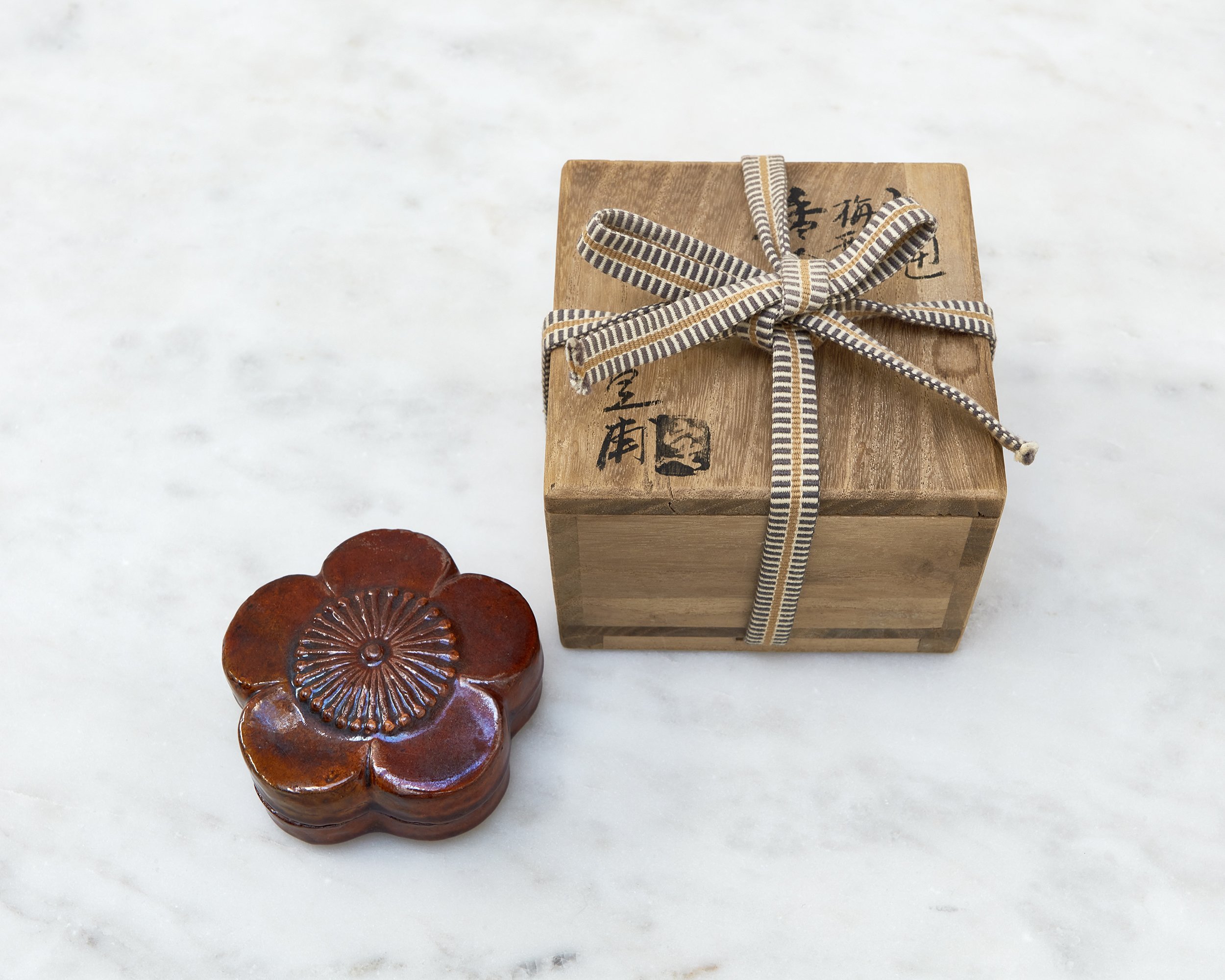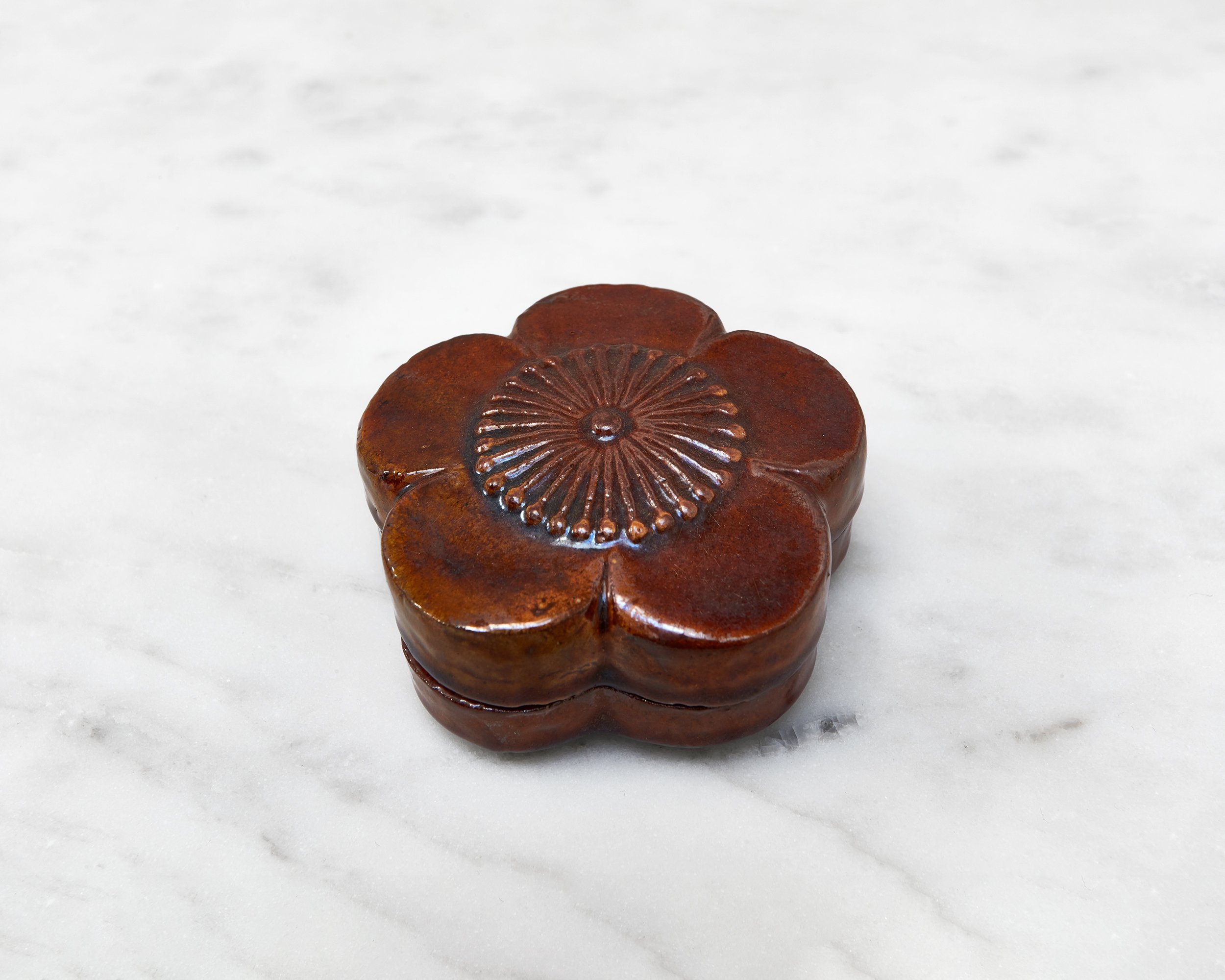Ohi Yaki "Kogo" - Perfume case by Joho Ohi
Crafted by the skilled hands of Joho Nakamura (中村定甫) from the esteemed Ohi family, this exquisite "Kogo" incense case takes the form of a delicate plum blossom, evoking elegance and refinement. Its deep brown-colored glaze lends it an air of sophistication and timeless beauty. Presented in a meticulously crafted Hinoki box, this piece embodies the harmonious fusion of traditional craftsmanship and contemporary aesthetics, making it a prized addition to any discerning collector's repertoire.
Ohi yaki
During the early years of the Edo period, in the illustrious sixth year of the Kanbun era (1666), Maeda Tsunanori, the esteemed fifth lord presiding over the Kaga Domain, renowned for its abundant one million koku rice yield, extended a gracious invitation to Sen Sotan. This venerable figure, hailing from Kyoto, was summoned to assume the esteemed position of overseer of tea ceremony utensils. Accompanying Sen Sotan on this occasion was none other than Tsuchiya Chosuke, a skilled ceramic artisan who had diligently apprenticed under the tutelage of Raku Kichizaemon, the fourth successor in the esteemed lineage of the Raku family.
Even after Sen Sotan's departure back to Kyoto in the third year of the Jokyo era (1686), Chosuke remained steadfast in his pursuits. His dedication bore fruit when he stumbled upon a cache of suitable clay in Ohimura, situated within the verdant confines of the Kawakita District (nowadays, Ohimachi, ensconced within the embrace of Kanazawa City). This fortuitous discovery marked the genesis of what would later be christened as Ohimura ware, a distinguished legacy that thrived as the designated kiln of the Maeda clan.
The annals of history reveal a momentary ebb in the fortunes of Ohimura ware during the epoch of the Meiji Restoration, as the protective patronage of the Kaga Domain waned. However, the indomitable spirit of this revered craft found renewed vigor amidst the stability engendered by evolving societal norms and the burgeoning dissemination of the cherished tea ceremony culture.
Ohimura ware embodies an exquisite artistry born of manual dexterity, eschewing the conventional potter's wheel in favor of a method that requires deft manipulation by hand. Each creation is meticulously honed into form through the deft caress of a spatula, a testament to the artisan's unwavering commitment to perfection. Following a meticulous process of glazing and rapid firing within diminutive kilns, the pieces are swiftly plunged into a realm of cooling tranquility. It is within this crucible of intense thermal dynamics that the distinctive allure of Ohimura ware is truly born, a captivating fusion of hues suffused with an ineffable warmth that resonates harmoniously with the ethereal snowscapes of its native terrain.
The cityscape of Hashiba-machi, ensconced within the heart of Kanazawa City, stands as a veritable bastion of artistic heritage, boasting the presence of the venerable tenth-generation Ohimura Chosuke Kiln and the resplendent Ohimura Museum of Art.
Crafted by the skilled hands of Joho Nakamura (中村定甫) from the esteemed Ohi family, this exquisite "Kogo" incense case takes the form of a delicate plum blossom, evoking elegance and refinement. Its deep brown-colored glaze lends it an air of sophistication and timeless beauty. Presented in a meticulously crafted Hinoki box, this piece embodies the harmonious fusion of traditional craftsmanship and contemporary aesthetics, making it a prized addition to any discerning collector's repertoire.
Ohi yaki
During the early years of the Edo period, in the illustrious sixth year of the Kanbun era (1666), Maeda Tsunanori, the esteemed fifth lord presiding over the Kaga Domain, renowned for its abundant one million koku rice yield, extended a gracious invitation to Sen Sotan. This venerable figure, hailing from Kyoto, was summoned to assume the esteemed position of overseer of tea ceremony utensils. Accompanying Sen Sotan on this occasion was none other than Tsuchiya Chosuke, a skilled ceramic artisan who had diligently apprenticed under the tutelage of Raku Kichizaemon, the fourth successor in the esteemed lineage of the Raku family.
Even after Sen Sotan's departure back to Kyoto in the third year of the Jokyo era (1686), Chosuke remained steadfast in his pursuits. His dedication bore fruit when he stumbled upon a cache of suitable clay in Ohimura, situated within the verdant confines of the Kawakita District (nowadays, Ohimachi, ensconced within the embrace of Kanazawa City). This fortuitous discovery marked the genesis of what would later be christened as Ohimura ware, a distinguished legacy that thrived as the designated kiln of the Maeda clan.
The annals of history reveal a momentary ebb in the fortunes of Ohimura ware during the epoch of the Meiji Restoration, as the protective patronage of the Kaga Domain waned. However, the indomitable spirit of this revered craft found renewed vigor amidst the stability engendered by evolving societal norms and the burgeoning dissemination of the cherished tea ceremony culture.
Ohimura ware embodies an exquisite artistry born of manual dexterity, eschewing the conventional potter's wheel in favor of a method that requires deft manipulation by hand. Each creation is meticulously honed into form through the deft caress of a spatula, a testament to the artisan's unwavering commitment to perfection. Following a meticulous process of glazing and rapid firing within diminutive kilns, the pieces are swiftly plunged into a realm of cooling tranquility. It is within this crucible of intense thermal dynamics that the distinctive allure of Ohimura ware is truly born, a captivating fusion of hues suffused with an ineffable warmth that resonates harmoniously with the ethereal snowscapes of its native terrain.
The cityscape of Hashiba-machi, ensconced within the heart of Kanazawa City, stands as a veritable bastion of artistic heritage, boasting the presence of the venerable tenth-generation Ohimura Chosuke Kiln and the resplendent Ohimura Museum of Art.
Crafted by the skilled hands of Joho Nakamura (中村定甫) from the esteemed Ohi family, this exquisite "Kogo" incense case takes the form of a delicate plum blossom, evoking elegance and refinement. Its deep brown-colored glaze lends it an air of sophistication and timeless beauty. Presented in a meticulously crafted Hinoki box, this piece embodies the harmonious fusion of traditional craftsmanship and contemporary aesthetics, making it a prized addition to any discerning collector's repertoire.
Ohi yaki
During the early years of the Edo period, in the illustrious sixth year of the Kanbun era (1666), Maeda Tsunanori, the esteemed fifth lord presiding over the Kaga Domain, renowned for its abundant one million koku rice yield, extended a gracious invitation to Sen Sotan. This venerable figure, hailing from Kyoto, was summoned to assume the esteemed position of overseer of tea ceremony utensils. Accompanying Sen Sotan on this occasion was none other than Tsuchiya Chosuke, a skilled ceramic artisan who had diligently apprenticed under the tutelage of Raku Kichizaemon, the fourth successor in the esteemed lineage of the Raku family.
Even after Sen Sotan's departure back to Kyoto in the third year of the Jokyo era (1686), Chosuke remained steadfast in his pursuits. His dedication bore fruit when he stumbled upon a cache of suitable clay in Ohimura, situated within the verdant confines of the Kawakita District (nowadays, Ohimachi, ensconced within the embrace of Kanazawa City). This fortuitous discovery marked the genesis of what would later be christened as Ohimura ware, a distinguished legacy that thrived as the designated kiln of the Maeda clan.
The annals of history reveal a momentary ebb in the fortunes of Ohimura ware during the epoch of the Meiji Restoration, as the protective patronage of the Kaga Domain waned. However, the indomitable spirit of this revered craft found renewed vigor amidst the stability engendered by evolving societal norms and the burgeoning dissemination of the cherished tea ceremony culture.
Ohimura ware embodies an exquisite artistry born of manual dexterity, eschewing the conventional potter's wheel in favor of a method that requires deft manipulation by hand. Each creation is meticulously honed into form through the deft caress of a spatula, a testament to the artisan's unwavering commitment to perfection. Following a meticulous process of glazing and rapid firing within diminutive kilns, the pieces are swiftly plunged into a realm of cooling tranquility. It is within this crucible of intense thermal dynamics that the distinctive allure of Ohimura ware is truly born, a captivating fusion of hues suffused with an ineffable warmth that resonates harmoniously with the ethereal snowscapes of its native terrain.
The cityscape of Hashiba-machi, ensconced within the heart of Kanazawa City, stands as a veritable bastion of artistic heritage, boasting the presence of the venerable tenth-generation Ohimura Chosuke Kiln and the resplendent Ohimura Museum of Art.





